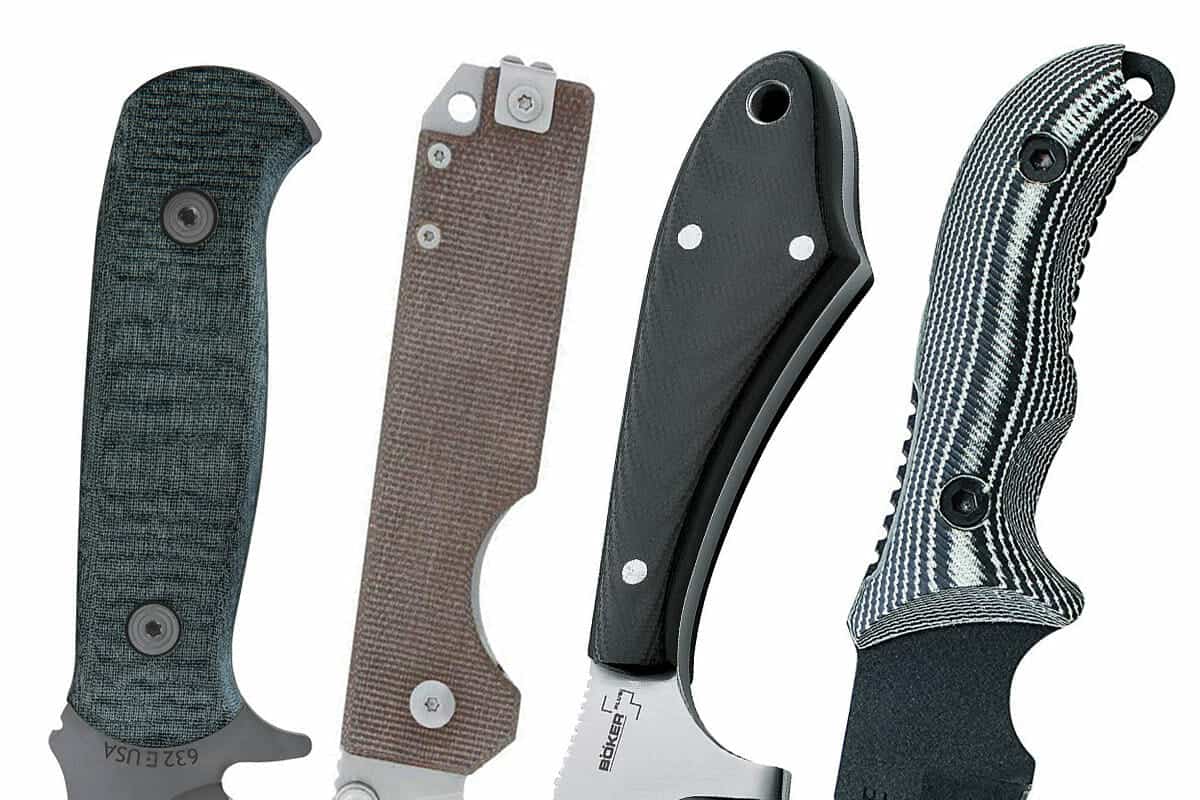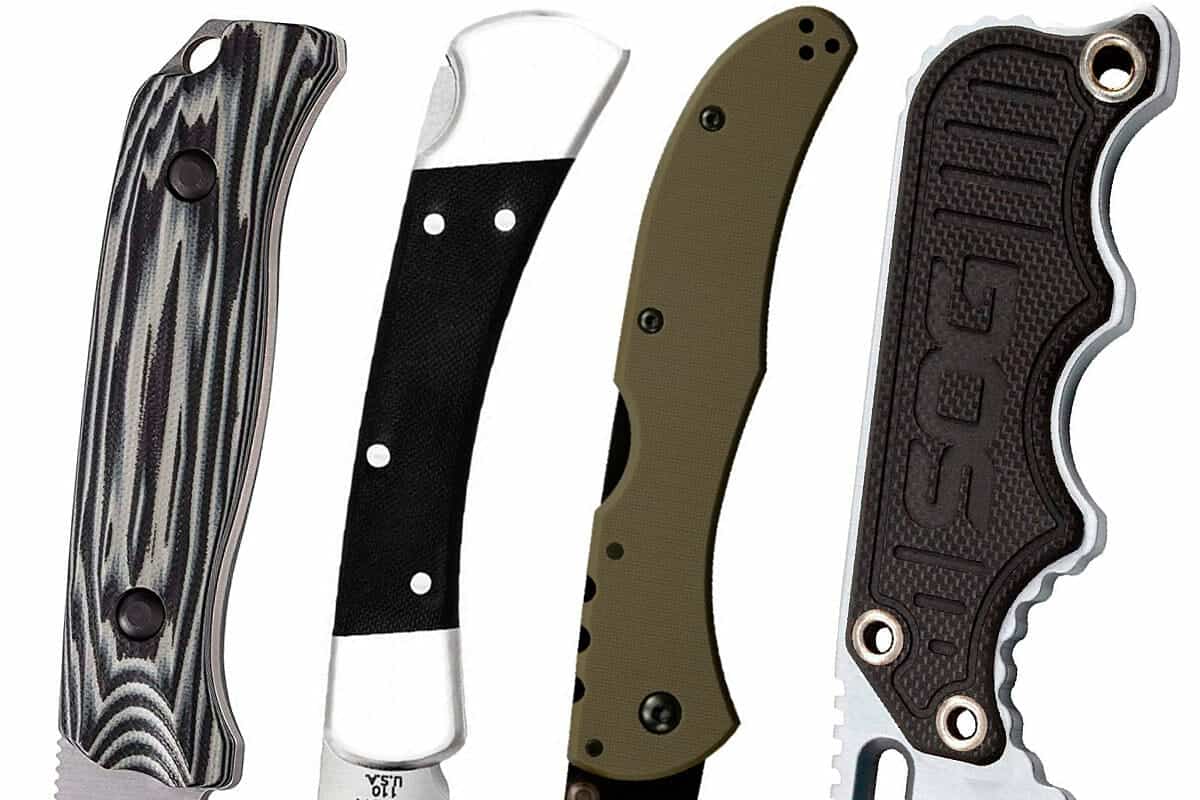Here’s Not Quite Everything You Wanted to Know About Phenolic Knife Scales
I don’t know about the rest of the knife geniuses out in the world, but the first hundred or so times I heard the phrase “Micarta handle” I didn’t know what the hell it was. Even after I handled a few Micarta knives, I wasn’t sure what I was handling. I became doubly confused after picking up something with G-10 scales and it kind of felt like basically the same thing as Micarta, just not as good. Apparently.
After a while I got tired of pretending to know what I was talking about and actually go find out for myself. The easy way to answer the question is that both Micarta and G10 are actually what’s called phenolic laminates, and in that sense they’re the same thing so we can all go home now.
Except anyone who’s looked at or picked up both a G-10 and a Micarta handled knife insist there’s a significant difference and yell at all of us about it on the forums. So I’ve explained what I found to the best of ability here for anyone else who’s tired of pretending to know what their knife handles are actually made of.
What is Micarta?

Pros: Comfort, grippiness, very tough
Cons: More expensive, more susceptible to water
The short answer is that Micarta is some kind of linen or fiber cloth material in a thermoset resin. Basically one or several kinds of cloth materials soaked in resin and cooked to hardness.
But when you talk about “Micarta” specifically you’re actually talking about a business. Norplex Micarta is the company responsible for the materials on a lot of the resin handles we see on knives today, and over the years they’ve become so prominent as to make themselves the Kleenex of the resin materials world.
Generally when we say Micarta, though, we’re not just talking about any kind of resin composite. There’s a reason we talk about G-10 handles and then we talk about Micarta handles.
Micarta usually means a handle has a base material of linen, canvas, or paper. It covers a broad range of materials, though, including wood and denim. What you’ll see most of the time on production knives is canvas and linen, and maybe some combination of materials throughout the layers.
A Quick Explanation of How Micarta is Made
If you’ve ever looked into this kind of thing yourself, you’ve almost certainly stumbled onto the vast fields of DIY Micarta scales videos. Most of those will give you a good idea of the process: sections of cloth get soaked in a resin then set in a mold, and squeezed together with clamps until they dry.
After the resin sets you end up with a slab of Micarta you can hopefully grind down into knife scales. That’s a simplified version of what usually happens at an industrial level, but it does give you a good idea of the versatility.
Depending on the material being used, there’s all kinds of things you can do with style by coloring the resin used to the soak the layers and the kind of mold being used. And since it’s all stuff you can buy from any hardware store, it’s comparatively easy to get going on your own.
Making G-10, however, would be a significantly more complex thing to make at home.
Check out our article on The Best Knives With Micarta Handle Scales if you are in the market for a knife with a comfy handle.
So What’s G-10?

Pros: Lightweight, low moisture absorption, lower cost, better at taking color
Cons: Not as tough or comfortable, dangerous to work with
It’s fiberglass in a resin thermosetting. More or less. Specifically it’s grade 10 Garolite, which is a range of composite materials mixed, heated, and pressed together to make it a lot tougher and smoother than regular fiberglass. Also that term “Garolite” is a brand name like Micarta, but I’ll be damned if I can pin down the company that actually has the copyright to it.
G-10 is Probably not a Good DIY Project
Basically G-10 is the same thing as Micarta, only fiberglass instead of linen or other naturally fibrous materials. There are some additional hazards involved in manufacturing this stuff, because, you know, fiberglass, which is the reason you will find a lot fewer DIY videos on working with it, and pretty much no videos on making the raw materials for it.
But it also comes out cheaper just on a materials cost basis. G-10 specifically is made with resin soaked fiberglass cloth that have been layered, pressed, and heated together similar to Micarta, but it’s working off a raw material that comes much cheaper in bulk.
The great thing about G-10 is that it’s really easy to customize. Generally when a knife company makes a knife with G-10 scales, they’ll offer it in at least three or four different colors. It’s also typically lighter than linen-based phenolic handles. And while I’m inclined to say that most Micarta handles will be tougher than G-10, I’m pretty sure if you were to do a side by side impact test on them (assuming both are made well) they would come out about the same, or close enough not to matter.
That’s It, Nerd, Now Go Away
Supposedly there are slight differences in texture between the various types of phenolic laminates but usually not enough for us to notice unless we’re really paying attention, or the base material itself is grooved somehow. With both Micarta and G-10, any prominent texture we see in the end product is added after the resin has been heated, which might add to the labor price a bit, but adds a lot to the versatility. That’s why there can be such a huge difference in picking up my Kizer Begleiter versus my much rougher but cost effective Esee Zancudo, even though they both sport G-10 scales.
This stuff has a wide range of uses in the industrial world since it’s fairly tough and cost effective, and has a lot of useful properties like insulating electricity and being highly heat resistant. For our purposes, though, it’s as close to a perfect balance of lightweight and tough as we could ask for in a knife handle.

Great explanation of the two materials.
What could you tell me about the Buck ‘phenolic’ handle? It is really smooth, Is it just polished? Also , for example, I have a cheap Kissing crane fixed blade with black smooth, shiny scales. It has dulled on it’s fat part so I’m guessing that it is just plastic. Would the phenolic Buck scales dull or scratch easy as well, or would wood, which can be ‘fixed’ be a better choice for one who is looking for a no mar handle?
Phenolic is basically a hard baked plastic material. It’s pretty tough. Definitely tougher than most wood handles, and it usually keeps its image over time pretty well. You might see a little bit of the color dull, and I’ve heard they can crack, but it’s pretty rare and takes a lot of abuse.
I don’t know why, but back in the 60’s, I think, Buck started pumping out knives like the 119 and 120 with the really smooth handles. The material is clearly good, because I’ve seen some of those knives from the 60’s still in use today, but the initial slipperiness of them is a common complaint. I’ve talked to people who ran sandpaper over their handles to rough up the texture and then they feel great, but that might void the warranty.
And that’s all the knowledge I have to give. Hope that helps, Doug.
Garolite® is a registered trademark of McMaster-Carr for their G-10/FR4 line of materials.
Fenhar G10 FR4 is a premium product that can be used in other environments besides tool holders.